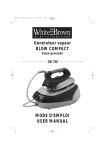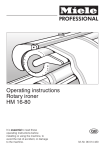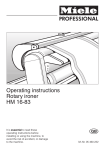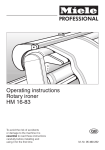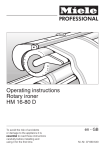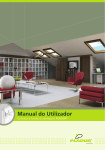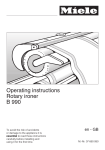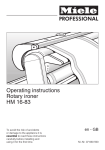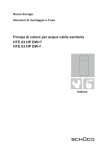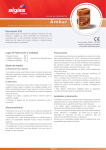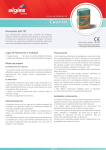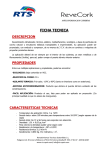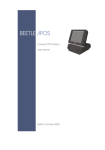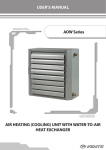Download User`s manual
Transcript
Customer ser vice 902 023 323 www.pladur.com [email protected] User’s manual Learn all about the advantages of Pladur ® ER-07351997 ER-07351997 Valdemoro Central Offices and Factory - Madrid Laminated Plasterboard Sheets, Manufactured Products and Adhesive Pastes. PLADUR® is a registered trademark of Grupo URALITA • 1/February 2008 EDITION CONTENTS WELCOME TO YOUR NEW PLADUR® HOUSE » Pladur® registered trademark 3 4 PLADUR® SYSTEMS » Inner partition walls » Outer partition walls » Wall linings » Ceilings 5 6 7 7 8 ANCHORS » Types of load » Installation » Anchors for downward loads on partition walls and linings » Anchors for eccentric loads on partition walls and linings » Loads on ceilings 9 10 12 15 DECORATION » With paint » With tiles » With wallpaper or fabric 23 24 25 26 MAINTENANCE AND SMALL REPAIRS » Minor damage » Repairs in which it is necessary to replace a PLADUR® board » Another practical solution for replacing sections of damaged PLADUR® 27 28 29 TYPES OF FIXING 31 17 22 30 1 WELCOME TO YOUR NEW PLADUR® HOUSE 1 2 WELCOME TO YOUR NEW PLADUR® HOUSE PLADUR PLADUR® REGISTERED TRADEMARK PLADUR® is a registered trademark for interior plasterboard for ceilings, partition walls and wall linings marketed by Yesos Ibéricos S.A., a Grupo Uralita company. With over 25 years’ experience in the Iberian market, PLADUR® is the leading brand in interior construction, with its own production center in Spain. It is the market leader in millions of m2 installed and leader in services for its customers PLADUR® is a range of building materials and services especially designed for interior construction: partition walls, ceilings and lining (facing for walls). The elements which make up PLADUR® systems are combined to construct the basic pieces of interior construction. There is a PLADUR® system suitable for every use. The elements which make up PLADUR® systems are: sheet(s) of laminated PLADUR® plasterboard covered with two layers of special multilayer cellulose. The product is marketed in the form of boards of different widths. The material is pleasant to the touch, warm and not flammable. It can very easily be cut, screwed, drilled, nailed, glued and decorated and is also fire resistant, as well as providing thermal insulation, soundproofing and moisture regulation. The vertical and horizontal framework is galvanized steel, providing the system and the mineral wool which reinforces the acoustic and thermal properties with strength and sturdiness. PLADUR® products have the very highest quality, which has undergone testing. PLADUR® meets all regulations and has obtained a number of seals and stamps which guarantee its quality and compliance with safety requirements. ER-07351997 ER-07351997 ® SYSTEMS 1 2 WELCOME TO YOUR NEW PLADUR® HOUSE PLADUR PLADUR® REGISTERED TRADEMARK PLADUR® is a registered trademark for interior plasterboard for ceilings, partition walls and wall linings marketed by Yesos Ibéricos S.A., a Grupo Uralita company. With over 25 years’ experience in the Iberian market, PLADUR® is the leading brand in interior construction, with its own production center in Spain. It is the market leader in millions of m2 installed and leader in services for its customers PLADUR® is a range of building materials and services especially designed for interior construction: partition walls, ceilings and lining (facing for walls). The elements which make up PLADUR® systems are combined to construct the basic pieces of interior construction. There is a PLADUR® system suitable for every use. The elements which make up PLADUR® systems are: sheet(s) of laminated PLADUR® plasterboard covered with two layers of special multilayer cellulose. The product is marketed in the form of boards of different widths. The material is pleasant to the touch, warm and not flammable. It can very easily be cut, screwed, drilled, nailed, glued and decorated and is also fire resistant, as well as providing thermal insulation, soundproofing and moisture regulation. The vertical and horizontal framework is galvanized steel, providing the system and the mineral wool which reinforces the acoustic and thermal properties with strength and sturdiness. PLADUR® products have the very highest quality, which has undergone testing. PLADUR® meets all regulations and has obtained a number of seals and stamps which guarantee its quality and compliance with safety requirements. ER-07351997 ER-07351997 ® SYSTEMS 2 PLADUR® SYSTEMS PLADUR® SYSTEMS OUTER PARTITION WALLS Because of their special characteristics, PLADUR® systems must be handled differently from other systems on the market. Doing so will allow you to enjoy all of their advantages. Generally speaking, these are the partition walls which separate your home from the adjoining one or from the building’s communal areas such as landings, staircases, entrances, hallways, etc. Normal decoration and upkeep is possible in a PLADUR® home. However, it is necessary to have some technical information to be able to carry out these tasks properly and without damaging the walls and ceilings It is made up of two sturdy steel frameworks, onto which two or more PLADUR® boards of different thicknesses are screwed. As with the inner partition walls, the services run through the center of the structure, which also contains insulating material. We invite you to discover the different types of PLADUR® partition walls and facing. It is also possible to find mixed solutions, composed of a brick partition wall with PLADUR® on each side of it. WALL LININGS Linings are the facing on any type of non-partition wall which may be found in your home, whether interior or a façade. The two types most commonly used in home construction are: direct lining and self-supporting lining. » Direct lining is the building unit created by “sticking” a PLADUR®, board directly to the wall or columns. In the case of façades, this incorporates insulating material to give it the required thermal characteristics and prevent heat from entering and exiting. INNER PARTITION WALLS These are the walls which separate one room from another inside your home. Generally speaking, they are made up of a sturdy rust-proof steel framework with one or more PLADUR® boards of different thicknesses screwed to each side. The various services necessary for your home run though the center of the structure. These are incorporated into the partition wall when it is assembled without the need for any kind of channel, and therefore do not weaken the wall. The interior also contains insulating material to reinforce, if necessary, the structure’s thermal and acoustic insulation. » Self-supporting lining is made up of a sturdy galvanized steel framework onto which one or more PLADUR® boards of different thicknesses are screwed Façade walls include insulating material on the inside. 2 PLADUR® SYSTEMS PLADUR® SYSTEMS OUTER PARTITION WALLS Because of their special characteristics, PLADUR® systems must be handled differently from other systems on the market. Doing so will allow you to enjoy all of their advantages. Generally speaking, these are the partition walls which separate your home from the adjoining one or from the building’s communal areas such as landings, staircases, entrances, hallways, etc. Normal decoration and upkeep is possible in a PLADUR® home. However, it is necessary to have some technical information to be able to carry out these tasks properly and without damaging the walls and ceilings It is made up of two sturdy steel frameworks, onto which two or more PLADUR® boards of different thicknesses are screwed. As with the inner partition walls, the services run through the center of the structure, which also contains insulating material. We invite you to discover the different types of PLADUR® partition walls and facing. It is also possible to find mixed solutions, composed of a brick partition wall with PLADUR® on each side of it. WALL LININGS Linings are the facing on any type of non-partition wall which may be found in your home, whether interior or a façade. The two types most commonly used in home construction are: direct lining and self-supporting lining. » Direct lining is the building unit created by “sticking” a PLADUR®, board directly to the wall or columns. In the case of façades, this incorporates insulating material to give it the required thermal characteristics and prevent heat from entering and exiting. INNER PARTITION WALLS These are the walls which separate one room from another inside your home. Generally speaking, they are made up of a sturdy rust-proof steel framework with one or more PLADUR® boards of different thicknesses screwed to each side. The various services necessary for your home run though the center of the structure. These are incorporated into the partition wall when it is assembled without the need for any kind of channel, and therefore do not weaken the wall. The interior also contains insulating material to reinforce, if necessary, the structure’s thermal and acoustic insulation. » Self-supporting lining is made up of a sturdy galvanized steel framework onto which one or more PLADUR® boards of different thicknesses are screwed Façade walls include insulating material on the inside. 2 3 PLADUR® SYSTEMS ANCHORS CEILINGS PLADUR® suspended ceilings are made up of a structure bearing sturdy steel profiles which are suitably attached to a building slab and onto which PLADUR® boards are screwed. Like all PLADUR® units, its facing has a flat finish. Together with a special treatment for the joints and screws, this makes any type of final decoration possible. 2 3 PLADUR® SYSTEMS ANCHORS CEILINGS PLADUR® suspended ceilings are made up of a structure bearing sturdy steel profiles which are suitably attached to a building slab and onto which PLADUR® boards are screwed. Like all PLADUR® units, its facing has a flat finish. Together with a special treatment for the joints and screws, this makes any type of final decoration possible. 3 ANCHORS TYPES OF LOAD LOADS BY USE PLADUR® systems offer many advantages. Among these are the ease, speed and neatness with which the fixings necessary to attach objects or loads for decoration or other purposes can be installed. The ease and reliability of this is surprising. We will first discuss the objects to be attached, organized by their weight, use and volume. » Fixed objects, are those which, once they are hung, are not going to be moved, such as pictures, ornaments, mirrors, lamps, etc. LOADS BY WEIGHT » Light loads, of up to 15 kilograms, such as pictures, wall lights, ornaments, etc. » Moveable objects, unlike fixed objects, will later be subjected to stresses which can sometimes be very severe: coat racks, towel racks, toilet paper holders, hanging wardrobes, shelves, etc. » Medium loads, of up to 30 kilograms, such as small sets of shelves or individual shelves, larger mirrors, coat racks, towel bars or small cabinets. LOADS BY VOLUME » Downward load, objects which are attached to the wall without projecting very far from its surface. These transfer a downward load to the facing. That is, they subject the wall to downward pressure. » Heavy loads, of over 30 kilograms, such as water heaters, radiators or hanging cabinets. » Eccentric load, objects with a certain volume or which project from the surface transfer an eccentric load. In addition to subjecting the wall to downward pressure, they pull outwards. 10 11 3 ANCHORS TYPES OF LOAD LOADS BY USE PLADUR® systems offer many advantages. Among these are the ease, speed and neatness with which the fixings necessary to attach objects or loads for decoration or other purposes can be installed. The ease and reliability of this is surprising. We will first discuss the objects to be attached, organized by their weight, use and volume. » Fixed objects, are those which, once they are hung, are not going to be moved, such as pictures, ornaments, mirrors, lamps, etc. LOADS BY WEIGHT » Light loads, of up to 15 kilograms, such as pictures, wall lights, ornaments, etc. » Moveable objects, unlike fixed objects, will later be subjected to stresses which can sometimes be very severe: coat racks, towel racks, toilet paper holders, hanging wardrobes, shelves, etc. » Medium loads, of up to 30 kilograms, such as small sets of shelves or individual shelves, larger mirrors, coat racks, towel bars or small cabinets. LOADS BY VOLUME » Downward load, objects which are attached to the wall without projecting very far from its surface. These transfer a downward load to the facing. That is, they subject the wall to downward pressure. » Heavy loads, of over 30 kilograms, such as water heaters, radiators or hanging cabinets. » Eccentric load, objects with a certain volume or which project from the surface transfer an eccentric load. In addition to subjecting the wall to downward pressure, they pull outwards. 10 11 3 ANCHORS DRILL PROPERLY INSTALLATION Once the object to be hung has been considered, follow the steps below. First, analyze the facing. Then make the hole and install the wall plug. MEASURE THE THICKNESS Your home’s developer may have provided you with information about the PLADUR® systems in your home. This is important, because this will give you the thickness of the board you want to drill into and allow you to choose the appropriate wall plug. If this is not the case, you can use any of the following tricks: 1. If an outlet box is attached with screws, carefully remove it and check the thickness of the facing. If it does not have screws, this is because it has been attached with paste and it will be difficult to check the thickness with this trick. Make the holes to install the wall plugs with an electric drill, using high-speed steel bits. Choose a bit of the same diameter as the plug to be installed. If in doubt, it is always better to make the hole slightly smaller than the wall plug. Bits must have at least four centimeters of usable length. If you use a longer bit, be very careful never to exceed this length. To install very small plastic plugs, you can use a small hand brace and bit. Never try to make holes without a drill or drill bit – using a screwdriver or other pointed object, for example – as this will create distorted drill holes into which the plugs will not fit correctly. 2. At the spot where you are going to install a wall plug or fixing, make a hole with the thinnest drill bit you have. Push a fine piece of wire with a knot tied at the end into the hole. When the wire encounters no more resistance, pull gently outwards until you feel the knot catch on the back part of the board. Mark the wire at the outside level of the facing. Pull firmly on the wire to remove it and measure the thickness of the board on it. 3. For bathrooms, ventilation ducts are always covered with a grille. Remove this and measure the thickness of the facing in the space. 12 13 3 ANCHORS DRILL PROPERLY INSTALLATION Once the object to be hung has been considered, follow the steps below. First, analyze the facing. Then make the hole and install the wall plug. MEASURE THE THICKNESS Your home’s developer may have provided you with information about the PLADUR® systems in your home. This is important, because this will give you the thickness of the board you want to drill into and allow you to choose the appropriate wall plug. If this is not the case, you can use any of the following tricks: 1. If an outlet box is attached with screws, carefully remove it and check the thickness of the facing. If it does not have screws, this is because it has been attached with paste and it will be difficult to check the thickness with this trick. Make the holes to install the wall plugs with an electric drill, using high-speed steel bits. Choose a bit of the same diameter as the plug to be installed. If in doubt, it is always better to make the hole slightly smaller than the wall plug. Bits must have at least four centimeters of usable length. If you use a longer bit, be very careful never to exceed this length. To install very small plastic plugs, you can use a small hand brace and bit. Never try to make holes without a drill or drill bit – using a screwdriver or other pointed object, for example – as this will create distorted drill holes into which the plugs will not fit correctly. 2. At the spot where you are going to install a wall plug or fixing, make a hole with the thinnest drill bit you have. Push a fine piece of wire with a knot tied at the end into the hole. When the wire encounters no more resistance, pull gently outwards until you feel the knot catch on the back part of the board. Mark the wire at the outside level of the facing. Pull firmly on the wire to remove it and measure the thickness of the board on it. 3. For bathrooms, ventilation ducts are always covered with a grille. Remove this and measure the thickness of the facing in the space. 12 13 3 ANCHORS CHOOSE THE RIGHT ANCHOR When it comes to choosing the most suitable wall plugs or anchors, consider the thickness of the board you are going to drill into. The smooth barrel which wall plugs generally have must be approximately the same thickness as the board ((e) in the figure). Do not use large plugs for light loads. Ask the professional who supplies them for advice. Remember that sometimes a simple pin or nail inserted at an angle is sufficient. Boxes of anchors usually include instructions. This will give you more information to help you choose the right plug. ANCHORS FOR DOWNWARD LOWS ON PARTITION WALLS AND LININGS Remember that downward loads are those whose objects do not project very far from the wall, and so only exert downward force. (Up to 15 kg. per point) SINGLE-POINT LIGHT LOADS » Fixed objects: pictures, light mirrors, picture frames or ornaments. Attach these directly to the board using: » Floreat picture hangers or hooks. Maximum of 5 kilograms per anchoring point » Standard plastic fixings. » “Tulip” plastic fixings. Maximum of 5 kilograms per anchoring point » Self-drilling fixings. For boards with a thickness equal to or greater than 19 mm and facings made up of two or more boards The type and size of wall plug will depend on the wall and the type of load. To choose the ideal one, please follow the instructions in the four sections below. » Moveable elements: hangers, towel bars, toilet paper holders. Attach these directly to the board using: » Metal hollow wall anchor plugs small or mediumsized. » Plastic wall plugs: retractable or opening (plastplug or toggle type) NB: These types of anchor are defined in the “Types of fixing” section. MEDIUM SINGLE-POINT LOADS (Up to 30 kg. per point) Remember that medium loads included small sets of shelves, display cabinets, heavy wall lamps, large pictures, heavy mirrors, heavy curtains, etc. Both fixed and moveable loads can be anchored directly to the boards themselves, always using mediumsized or large hollow wall anchor, retractable, toggle, butterfly or similar model plugs. Leave a minimum of some 40 cm. between each anchoring point (Fig. 1, Page 16). Light cabinets and small sets of shelves which project more than 25 cm. from the wall should be considered eccentric loads. 14 15 3 ANCHORS CHOOSE THE RIGHT ANCHOR When it comes to choosing the most suitable wall plugs or anchors, consider the thickness of the board you are going to drill into. The smooth barrel which wall plugs generally have must be approximately the same thickness as the board ((e) in the figure). Do not use large plugs for light loads. Ask the professional who supplies them for advice. Remember that sometimes a simple pin or nail inserted at an angle is sufficient. Boxes of anchors usually include instructions. This will give you more information to help you choose the right plug. ANCHORS FOR DOWNWARD LOWS ON PARTITION WALLS AND LININGS Remember that downward loads are those whose objects do not project very far from the wall, and so only exert downward force. (Up to 15 kg. per point) SINGLE-POINT LIGHT LOADS » Fixed objects: pictures, light mirrors, picture frames or ornaments. Attach these directly to the board using: » Floreat picture hangers or hooks. Maximum of 5 kilograms per anchoring point » Standard plastic fixings. » “Tulip” plastic fixings. Maximum of 5 kilograms per anchoring point » Self-drilling fixings. For boards with a thickness equal to or greater than 19 mm and facings made up of two or more boards The type and size of wall plug will depend on the wall and the type of load. To choose the ideal one, please follow the instructions in the four sections below. » Moveable elements: hangers, towel bars, toilet paper holders. Attach these directly to the board using: » Metal hollow wall anchor plugs small or mediumsized. » Plastic wall plugs: retractable or opening (plastplug or toggle type) NB: These types of anchor are defined in the “Types of fixing” section. MEDIUM SINGLE-POINT LOADS (Up to 30 kg. per point) Remember that medium loads included small sets of shelves, display cabinets, heavy wall lamps, large pictures, heavy mirrors, heavy curtains, etc. Both fixed and moveable loads can be anchored directly to the boards themselves, always using mediumsized or large hollow wall anchor, retractable, toggle, butterfly or similar model plugs. Leave a minimum of some 40 cm. between each anchoring point (Fig. 1, Page 16). Light cabinets and small sets of shelves which project more than 25 cm. from the wall should be considered eccentric loads. 14 15 ANCHORS HEAVY SINGLE-POINT LOADS (Over 30 kg. per point) This section refers to objects such as water heaters, radiators, narrow yet heavy sets of shelves, etc. Generally speaking, installation of these objects has already been planned for during assembly of the PLADUR® systems and the necessary reinforcements have been placed inside the partition walls. ANCHORS FOR ECCENTRIC LOADS ON PARTITION WALLS AND LININGS Eccentric loads are those which project a great deal from the surface or which have a large volume, subjecting the wall to downward and outward pressure. LIGHT LOADS (Up to 75 Kg/ml) Eccentric loads are generally extended, created by voluminous objects whose center of gravity is some distance from the wall. This is the case of kitchen cabinets, shelving units with very wide shelves, etc. As we saw above, they pull away from the wall because they act as a lever arm. Should it be necessary to include a new load not previously anticipated, see the “Incorporating a reinforcement” section. EXTENDED LOADS In this section we are discussing only furniture which projects from the wall up to a maximum of 60 cm. If the depth exceeds this measure, further precautions must be taken. Please consult with PLADUR® technical services. Types of load such as long coat racks, heavy molding, large pictures or murals, etc. are handled the same way as single-point loads, taking the same precautions. Once we know the weight of the item, distribute the load over as many anchors as necessary (Fig. 2), in such a way that they do not exceed the 30 kg. per point established above, and that each anchoring point is separated by at least 40 cm. (Fig. 1). Choose the appropriate wall plug depending on the type of load (fixed or moveable), as indicated for single-point loads. To hang these items, follow the advice below: 1. Always use hollow wall anchor, retractable, toggle, butterfly, etc. wall plugs for anchoring. They can be attached directly to the board. 2. Each anchor must support a maximum of 25 kg. 3. Each load must be attached with a minimum of two anchors. 4. The table below shows the number of anchors recommended according to the weight and depth of the load. NUMBER OF ANCHORS RECOMMENDED BY WEIGHT AND DEPTH DEPTH OF CABINET OR SHELF Fig. 1: Minimum space between anchoring points 16 Fig. 2: Load distribution MAX. WEIGHT OF THE CABINET OR SHELF PER LINEAR METER 3 30 cm 40 cm 50 cm 60 cm 60 Kg 3 x x x 50 Kg 3 3 x x 40 Kg 2 2 2 x 30 Kg 2 2 2 2 X = Installing a cabinet or shelf of these characteristics is not recommended, as it places excessive strain on the PLADUR® wall. If this is done, it is essential that the PLADUR® wall be reinforced as indicated in the following section. 17 ANCHORS HEAVY SINGLE-POINT LOADS (Over 30 kg. per point) This section refers to objects such as water heaters, radiators, narrow yet heavy sets of shelves, etc. Generally speaking, installation of these objects has already been planned for during assembly of the PLADUR® systems and the necessary reinforcements have been placed inside the partition walls. ANCHORS FOR ECCENTRIC LOADS ON PARTITION WALLS AND LININGS Eccentric loads are those which project a great deal from the surface or which have a large volume, subjecting the wall to downward and outward pressure. LIGHT LOADS (Up to 75 Kg/ml) Eccentric loads are generally extended, created by voluminous objects whose center of gravity is some distance from the wall. This is the case of kitchen cabinets, shelving units with very wide shelves, etc. As we saw above, they pull away from the wall because they act as a lever arm. Should it be necessary to include a new load not previously anticipated, see the “Incorporating a reinforcement” section. EXTENDED LOADS In this section we are discussing only furniture which projects from the wall up to a maximum of 60 cm. If the depth exceeds this measure, further precautions must be taken. Please consult with PLADUR® technical services. Types of load such as long coat racks, heavy molding, large pictures or murals, etc. are handled the same way as single-point loads, taking the same precautions. Once we know the weight of the item, distribute the load over as many anchors as necessary (Fig. 2), in such a way that they do not exceed the 30 kg. per point established above, and that each anchoring point is separated by at least 40 cm. (Fig. 1). Choose the appropriate wall plug depending on the type of load (fixed or moveable), as indicated for single-point loads. To hang these items, follow the advice below: 1. Always use hollow wall anchor, retractable, toggle, butterfly, etc. wall plugs for anchoring. They can be attached directly to the board. 2. Each anchor must support a maximum of 25 kg. 3. Each load must be attached with a minimum of two anchors. 4. The table below shows the number of anchors recommended according to the weight and depth of the load. NUMBER OF ANCHORS RECOMMENDED BY WEIGHT AND DEPTH DEPTH OF CABINET OR SHELF Fig. 1: Minimum space between anchoring points 16 Fig. 2: Load distribution MAX. WEIGHT OF THE CABINET OR SHELF PER LINEAR METER 3 30 cm 40 cm 50 cm 60 cm 60 Kg 3 x x x 50 Kg 3 3 x x 40 Kg 2 2 2 x 30 Kg 2 2 2 2 X = Installing a cabinet or shelf of these characteristics is not recommended, as it places excessive strain on the PLADUR® wall. If this is done, it is essential that the PLADUR® wall be reinforced as indicated in the following section. 17 3 ANCHORS MEDIUM AND HEAVY LOADS (Over 75 kg per ml) These must be anchored to the framework of the partition walls or reinforced with sturdy elements. We recommend that you check with PLADUR® technical services. For this type of load, a reinforcement is generally installed in the interior of the partition wall during assembly of the PLADUR® system. If it is necessary to install new reinforcements, it is preferable to obtain the advice of a specialized installer. However, you can also follow the steps below: b/ Incorporating a reinforcement into façades. When it is necessary to incorporate reinforcement into a PLADUR® façade board, follow the instructions below. NB: In the case of self-supporting lining, reinforcements are installed in the same manner as on partition walls. You must first locate the studs, following the instructions indicated on page 20 in Fig. 2. 1. With the help of a keyhole saw or jigsaw, cut an opening in the PLADUR® wall big enough to insert a plug or wooden lath. » How do I anchor medium or heavy loads on façade walls? In the case of PLADUR® “stuck” directly to the wall, called direct lining, the following two options are possible: a/ Direct Anchoring 1. Drill a hole in the wall and insert a wall plug and screw long enough to expand the plug. 2. It is also possible to insert a plastic or metal wall plug more than four or five centimeters of the total thickness of the PLADUR® lining. 18 2. Solution A. Attach it to the wall or insert it inside. Now you can attach the same board you cut out, screwing it to the wooden piece and placing four daubs of PLADUR® anchoring paste on the four corners. 2. Solution B. If you do not want to attach the wooden plug, attach it to the wall with appropriate wall plugs and position the original board as indicated above. 19 3 ANCHORS MEDIUM AND HEAVY LOADS (Over 75 kg per ml) These must be anchored to the framework of the partition walls or reinforced with sturdy elements. We recommend that you check with PLADUR® technical services. For this type of load, a reinforcement is generally installed in the interior of the partition wall during assembly of the PLADUR® system. If it is necessary to install new reinforcements, it is preferable to obtain the advice of a specialized installer. However, you can also follow the steps below: b/ Incorporating a reinforcement into façades. When it is necessary to incorporate reinforcement into a PLADUR® façade board, follow the instructions below. NB: In the case of self-supporting lining, reinforcements are installed in the same manner as on partition walls. You must first locate the studs, following the instructions indicated on page 20 in Fig. 2. 1. With the help of a keyhole saw or jigsaw, cut an opening in the PLADUR® wall big enough to insert a plug or wooden lath. » How do I anchor medium or heavy loads on façade walls? In the case of PLADUR® “stuck” directly to the wall, called direct lining, the following two options are possible: a/ Direct Anchoring 1. Drill a hole in the wall and insert a wall plug and screw long enough to expand the plug. 2. It is also possible to insert a plastic or metal wall plug more than four or five centimeters of the total thickness of the PLADUR® lining. 18 2. Solution A. Attach it to the wall or insert it inside. Now you can attach the same board you cut out, screwing it to the wooden piece and placing four daubs of PLADUR® anchoring paste on the four corners. 2. Solution B. If you do not want to attach the wooden plug, attach it to the wall with appropriate wall plugs and position the original board as indicated above. 19 3 ANCHORS 3. Plaster the resulting joints and screws, using PLADUR® reinforcement tape and joint paste. b/ Incorporating a reinforcement into partition walls. 1. With the help of a jigsaw, cut an opening in the PLADUR® wall which runs from the axis of one vertical stud to the axis of the next one. » How do I anchor medium and heavy loads on partition walls? Two options are also available here: a/ Anclaje Directo. 2. Fit and screw in a wooden reinforcement between the two studs (one end can be fitted and the other anchored.) Check that the reinforcement is firmly attached to both. 1. Locate the vertical studs of the partition wall framework and anchor directly to these, using hollow wall anchor or similar wall plugs. 3. Place pieces of wood in the upper and lower parts of the hole, screwing them to the boards 2. The stud can be located using a small magnet or “metal-seeking” instrument. (These are not expensive, and can be found in hardware stores.) 4. Replace the same board cut out at the beginning and screw it to the pieces of wood and the studs. Then plaster the joints and screws using PLADUR® reinforcement tape and joint paste. 20 21 3 ANCHORS 3. Plaster the resulting joints and screws, using PLADUR® reinforcement tape and joint paste. b/ Incorporating a reinforcement into partition walls. 1. With the help of a jigsaw, cut an opening in the PLADUR® wall which runs from the axis of one vertical stud to the axis of the next one. » How do I anchor medium and heavy loads on partition walls? Two options are also available here: a/ Anclaje Directo. 2. Fit and screw in a wooden reinforcement between the two studs (one end can be fitted and the other anchored.) Check that the reinforcement is firmly attached to both. 1. Locate the vertical studs of the partition wall framework and anchor directly to these, using hollow wall anchor or similar wall plugs. 3. Place pieces of wood in the upper and lower parts of the hole, screwing them to the boards 2. The stud can be located using a small magnet or “metal-seeking” instrument. (These are not expensive, and can be found in hardware stores.) 4. Replace the same board cut out at the beginning and screw it to the pieces of wood and the studs. Then plaster the joints and screws using PLADUR® reinforcement tape and joint paste. 20 21 3 4 ANCHORS D E C O R AT I O N LOADS ON CEILINGS In all cases, you must use large anchors or butterfly, spring toggle or hollow wall anchor plugs. LOADS UP TO 3 KG Install hanging form the board itself, using the wall plugs mentioned above. There must be at least 40 cm. between anchors. LOADS OF 3 TO 10 Kg These must be anchored to the metal framework which runs through the interior of PLADUR® ceilings. Anchors on a single profile must be separated by at least 1.20 m. Use wall plugs like those indicated above. LOADS OF MORE THAN 10 Kg These loads must be anchored to the building slab. Now that we have seen the wall plugs which must be used and all the measures to employ, once again we recommend that you consult “Types of Fixing” to recognize them more easily. 22 3 4 ANCHORS D E C O R AT I O N LOADS ON CEILINGS In all cases, you must use large anchors or butterfly, spring toggle or hollow wall anchor plugs. LOADS UP TO 3 KG Install hanging form the board itself, using the wall plugs mentioned above. There must be at least 40 cm. between anchors. LOADS OF 3 TO 10 Kg These must be anchored to the metal framework which runs through the interior of PLADUR® ceilings. Anchors on a single profile must be separated by at least 1.20 m. Use wall plugs like those indicated above. LOADS OF MORE THAN 10 Kg These loads must be anchored to the building slab. Now that we have seen the wall plugs which must be used and all the measures to employ, once again we recommend that you consult “Types of Fixing” to recognize them more easily. 22 4 D E C O R AT I O N Painting, papering or tiling your PLADUR® walls will be simpler and more eye-catching than with conventional walls. WITH TILES First prime the surface to be tiled. Always use cement glue applied to the surface using a serrated trowel. Do not do this over a very large area, making sure you install the tiles before the cement dries. WITH PAINT To paint your PLADUR® walls, proceed exactly as you would with any other type of wall or ceiling. It is necessary to first prime the surface. This way the facing will have the same texture as the entire surface and provide a better finish. This will also make later maintenance easier. If the PLADUR® surface is already painted and you want to touch up or change the paint, proceed as follows: If you want to re-cover the tiling, there are several possibilities: 1. There are various types of cement on the market which allow you to glue a new layer of tiles over an existing one, provided that the latter is firmly attached. » If the existing paint is flat tempera, skip troweled or stipple finished, moisten the surface slightly with a brush and clean water. Then carefully lift off the old paint with a spatula. Allow the surface to dry. Plaster over any small imperfections which have appeared. Allow to dry and lightly sand the surface. Apply a coat of primer. You can then repaint or decorate. 2. Another option is gluing a 6.5 or 10 mm. board of PLADUR® over the tiling, anchoring it with plugs while gluing. On top of this you can re-tile, paint, paper, etc. » If the old paint is vinyl, synthetic enamel or oil, only those areas which are loose or where bubbles have formed must be removed. Plaster the damaged areas, sand and apply a coat of primer before applying the new paint. Remember that in order to obtain a good finish, you must apply at least two coats of paint, being sure to apply the second coat perpendicular to the first. 3. Lastly, you can remove the old tiles, using a thick spatula as a lever on each of them. Once all the pieces of old tile are removed, there are two possibilities: » Scratch the adhered cement glue hard – if the surface is primed, this will be much easier – and then plaster over any damaged areas, apply primer and redecorate. » Another alternative is leveling the surface with cement glue, allowing it to dry and then re-tiling. 24 25 4 D E C O R AT I O N Painting, papering or tiling your PLADUR® walls will be simpler and more eye-catching than with conventional walls. WITH TILES First prime the surface to be tiled. Always use cement glue applied to the surface using a serrated trowel. Do not do this over a very large area, making sure you install the tiles before the cement dries. WITH PAINT To paint your PLADUR® walls, proceed exactly as you would with any other type of wall or ceiling. It is necessary to first prime the surface. This way the facing will have the same texture as the entire surface and provide a better finish. This will also make later maintenance easier. If the PLADUR® surface is already painted and you want to touch up or change the paint, proceed as follows: If you want to re-cover the tiling, there are several possibilities: 1. There are various types of cement on the market which allow you to glue a new layer of tiles over an existing one, provided that the latter is firmly attached. » If the existing paint is flat tempera, skip troweled or stipple finished, moisten the surface slightly with a brush and clean water. Then carefully lift off the old paint with a spatula. Allow the surface to dry. Plaster over any small imperfections which have appeared. Allow to dry and lightly sand the surface. Apply a coat of primer. You can then repaint or decorate. 2. Another option is gluing a 6.5 or 10 mm. board of PLADUR® over the tiling, anchoring it with plugs while gluing. On top of this you can re-tile, paint, paper, etc. » If the old paint is vinyl, synthetic enamel or oil, only those areas which are loose or where bubbles have formed must be removed. Plaster the damaged areas, sand and apply a coat of primer before applying the new paint. Remember that in order to obtain a good finish, you must apply at least two coats of paint, being sure to apply the second coat perpendicular to the first. 3. Lastly, you can remove the old tiles, using a thick spatula as a lever on each of them. Once all the pieces of old tile are removed, there are two possibilities: » Scratch the adhered cement glue hard – if the surface is primed, this will be much easier – and then plaster over any damaged areas, apply primer and redecorate. » Another alternative is leveling the surface with cement glue, allowing it to dry and then re-tiling. 24 25 4 5 D E C O R AT I O N WITH WALLPAPER OR FABRIC Before applying wallpaper, it is very important to prime the entire surface first. This way, if you decide to remove the paper in the future, the job will be much easier. Of course, any type of paper can be hung. If the surface is already covered with wallpaper and you want to remove it, whether to hang new paper or change the type of decoration, moisten the wall as indicated for removing tempera paint. Little by little, the paper will lift away. Remove it gently with the help of a spatula. Gently sand the imperfections in the surface. If necessary, apply primer. You can now redecorate the surface as you like. For fabric, proceed normally as with any other type of wall. You can apply fabric with or without an undercloth. 26 MAINTENANCE A N D S M A L L R E PA I R S 4 5 D E C O R AT I O N WITH WALLPAPER OR FABRIC Before applying wallpaper, it is very important to prime the entire surface first. This way, if you decide to remove the paper in the future, the job will be much easier. Of course, any type of paper can be hung. If the surface is already covered with wallpaper and you want to remove it, whether to hang new paper or change the type of decoration, moisten the wall as indicated for removing tempera paint. Little by little, the paper will lift away. Remove it gently with the help of a spatula. Gently sand the imperfections in the surface. If necessary, apply primer. You can now redecorate the surface as you like. For fabric, proceed normally as with any other type of wall. You can apply fabric with or without an undercloth. 26 MAINTENANCE A N D S M A L L R E PA I R S 5 MAINTENANCE AND SMALL REPAIRS Keeping PLADUR® surfaces in perfect condition or repairing minor damage resulting from daily use is a simple task. Follow these instructions and your walls were always look brand new. REPAIRS WHERE IT IS NECESSARY TO REPLACE A PLADUR® BOARD If you have to replace a rather extensive area of PLADUR® or carry out significant repair work – for example, replace or repair plumbing – we recommend following the steps below: MINOR DAMAGE For minor damage such as scratches or chips where only the surface of the PLADUR® has been damaged, repair is very simple. 1. Cut out a piece of the board around the damaged area or where repair is needed with a keyhole saw or a jigsaw. 1. Scrape the damaged area with a knife to remove traces of loose cellulose and possible damaged plaster. 2. Repair the problem if necessary. (Remember that when cutting the board, you can choose the area which would result in less damage and require less repair.) 2. Apply a paint primer or sealant to prepare the surface. 3. Surround the interior of the space with profiles or pieces of wood, leaving half visible. Firmly screw these pieces to the board in place. 3. Finish off by applying a regular plaster with a spatula. If the area is somewhat large, we recommend PLADUR® joint paste. 28 4. Place a piece of PLADUR® board over the hole (If the previous one is only wet, allow it to dry and it can be reinstalled). Screw this board to the wood. Then make a beveled edge around the join and plaster it. If the hole to be covered is large, reinforce it with PLADUR® paper tape and cover with PLADUR® joint paste. 29 5 MAINTENANCE AND SMALL REPAIRS Keeping PLADUR® surfaces in perfect condition or repairing minor damage resulting from daily use is a simple task. Follow these instructions and your walls were always look brand new. REPAIRS WHERE IT IS NECESSARY TO REPLACE A PLADUR® BOARD If you have to replace a rather extensive area of PLADUR® or carry out significant repair work – for example, replace or repair plumbing – we recommend following the steps below: MINOR DAMAGE For minor damage such as scratches or chips where only the surface of the PLADUR® has been damaged, repair is very simple. 1. Cut out a piece of the board around the damaged area or where repair is needed with a keyhole saw or a jigsaw. 1. Scrape the damaged area with a knife to remove traces of loose cellulose and possible damaged plaster. 2. Repair the problem if necessary. (Remember that when cutting the board, you can choose the area which would result in less damage and require less repair.) 2. Apply a paint primer or sealant to prepare the surface. 3. Surround the interior of the space with profiles or pieces of wood, leaving half visible. Firmly screw these pieces to the board in place. 3. Finish off by applying a regular plaster with a spatula. If the area is somewhat large, we recommend PLADUR® joint paste. 28 4. Place a piece of PLADUR® board over the hole (If the previous one is only wet, allow it to dry and it can be reinstalled). Screw this board to the wood. Then make a beveled edge around the join and plaster it. If the hole to be covered is large, reinforce it with PLADUR® paper tape and cover with PLADUR® joint paste. 29 5 6 MAINTENANCE AND SMALL REPAIRS TYPES OF FIXING ANOTHER PRACTICAL SOLUTION FOR REPLACING SECTIONS OF DAMAGED PLADUR®. 1. With a pointed saw, cut a triangle out of the board, and if necessary make the repair. 2. Take the cut piece or a similar one, put a few daubs of PLADUR® anchoring paste or white glue on the corners and insert it into the hole. Position it “crosswise” and pull hard towards you until it is firmly attached. 3. If the size of the hole does not allow you to work comfortably, before inserting the piece in the hole, drill two holes in the center of the piece and run a wire through them, allowing you to pull better. Insert the piece, turn it and pull firmly towards you, using a stick or screwdriver as a “tourniquet”. 4. Clean off the excess anchoring paste and once the previous piece has set, apply a few daubs of paste or white glue (depending on what was used above) to a piece the exact size of the hole. Position it inside the hole and press down firmly. Finally, bevel the joints and plaster them, as in the previous example. 30 5 6 MAINTENANCE AND SMALL REPAIRS TYPES OF FIXING ANOTHER PRACTICAL SOLUTION FOR REPLACING SECTIONS OF DAMAGED PLADUR®. 1. With a pointed saw, cut a triangle out of the board, and if necessary make the repair. 2. Take the cut piece or a similar one, put a few daubs of PLADUR® anchoring paste or white glue on the corners and insert it into the hole. Position it “crosswise” and pull hard towards you until it is firmly attached. 3. If the size of the hole does not allow you to work comfortably, before inserting the piece in the hole, drill two holes in the center of the piece and run a wire through them, allowing you to pull better. Insert the piece, turn it and pull firmly towards you, using a stick or screwdriver as a “tourniquet”. 4. Clean off the excess anchoring paste and once the previous piece has set, apply a few daubs of paste or white glue (depending on what was used above) to a piece the exact size of the hole. Position it inside the hole and press down firmly. Finally, bevel the joints and plaster them, as in the previous example. 30 6 TYPES OF FIXING To assist you, we provide a full list of wall plugs and fixings which can be used on PLADUR® systems, as well as how they are installed and operate. Carefully chose the most suitable design and size, depending on the object to be hung. This will make your work perfect and lasting. Standard plastic fixings Recommended for loads of 5 to 10 kg. per point, depending on the diameter. Only for fixed and downward loads. Floreat picture hangers Recommended for maximum loads of 5 kg. per hook, 10 kg. for two and 15 kg. for three hooks. Only for fixed and downward loads. Hollow wall anchor plug Recommended for loads of 10 to 30 kg. per point, depending on the diameter, and ceilings. For moveable and fixed loads. “Tulip” plastic fixing Recommended for loads up to 5 kg. per point. Only for fixed and downward loads. 32 33 6 TYPES OF FIXING To assist you, we provide a full list of wall plugs and fixings which can be used on PLADUR® systems, as well as how they are installed and operate. Carefully chose the most suitable design and size, depending on the object to be hung. This will make your work perfect and lasting. Standard plastic fixings Recommended for loads of 5 to 10 kg. per point, depending on the diameter. Only for fixed and downward loads. Floreat picture hangers Recommended for maximum loads of 5 kg. per hook, 10 kg. for two and 15 kg. for three hooks. Only for fixed and downward loads. Hollow wall anchor plug Recommended for loads of 10 to 30 kg. per point, depending on the diameter, and ceilings. For moveable and fixed loads. “Tulip” plastic fixing Recommended for loads up to 5 kg. per point. Only for fixed and downward loads. 32 33 6 TYPES OF FIXING Plasplug or retractable cavity anchors Recommended for loads of 10 to 25 kg. per point, depending on the diameter. Spring toggle Recommended for hanging from ceilings. For fixed and moveable loads. Plastic toggle Recommended for loads of 10 to 15 kg. per point, depending on the model. Butterfly fixing Recommended for hanging from ceilings. For fixed and moveable loads. 34 35 6 TYPES OF FIXING Plasplug or retractable cavity anchors Recommended for loads of 10 to 25 kg. per point, depending on the diameter. Spring toggle Recommended for hanging from ceilings. For fixed and moveable loads. Plastic toggle Recommended for loads of 10 to 15 kg. per point, depending on the model. Butterfly fixing Recommended for hanging from ceilings. For fixed and moveable loads. 34 35 6 TY I PPOE SS D OEF CF U I XEILNGGU E S Self-drilling fixings For boards 19 mm or thicker and facings with two or more boards. For fixed and downward loads. NB: » These anchors can easily be purchased at hardware stores, hypermarkets and specialized DIY stores. » All load figures and wall plug choice indicated in this manual refer to work on facings made up of one board (13 mm or thicker). For facings made up of more boards, follow the same limits and plug choices indicated. 36 Customer ser vice 902 023 323 www.pladur.com [email protected] User’s manual Learn all about the advantages of Pladur ® ER-07351997 ER-07351997 Valdemoro Central Offices and Factory - Madrid Laminated Plasterboard Sheets, Manufactured Products and Adhesive Pastes. PLADUR® is a registered trademark of Grupo URALITA • 1/February 2008 EDITION






































